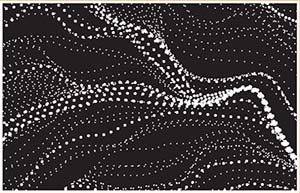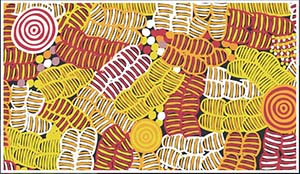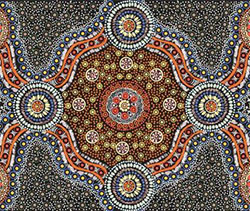M&S Textiles Australia
 Geographically, a dune is a hill of sand built by wind action that results in dunes of many different shapes and sizes. The importance of dunes is recognized by some countries namely United States, Australia, Canada and New Zealand which have developed significant programs for protecting dunes by stabilizing them. In Central Australia there are many beautiful sand hills which provide a habitat for highly specialized forms of flora and fauna.
Geographically, a dune is a hill of sand built by wind action that results in dunes of many different shapes and sizes. The importance of dunes is recognized by some countries namely United States, Australia, Canada and New Zealand which have developed significant programs for protecting dunes by stabilizing them. In Central Australia there are many beautiful sand hills which provide a habitat for highly specialized forms of flora and fauna.
Well known artist Anna Pitjara, beautifully depicts these sand hills on canvas with acrylic paints. Using white dots on a black background Anna portrays the effect of wind moving over the sand hills in the desert landscape near her hometown Utopia.
For thousands of years, aboriginal people were hunters and gatherers living entirely on the abundant wild food also known as 'bush tucker'. Nowadays many of them still eat this traditional food but they no longer rely on it for survival.
 Betty Mbitjana is an experienced and well known artist from Utopia, Central Australia, whose works are sought after in Australia as well as in other countries. She has inherited the Bush Melon Dreaming from her mother Minnie Pwerle(passed away), once of the great Aboriginal artists. The bush melon is a sweet bush tucker which once grew in abundance at Utopia. As well as providing water, these melons are a good source of some essential vitamins and minerals. Betty's mother and other aboriginal women would gather the fruit to be eaten at once, or to be stored for times when bush tucker was scarce.
Betty Mbitjana is an experienced and well known artist from Utopia, Central Australia, whose works are sought after in Australia as well as in other countries. She has inherited the Bush Melon Dreaming from her mother Minnie Pwerle(passed away), once of the great Aboriginal artists. The bush melon is a sweet bush tucker which once grew in abundance at Utopia. As well as providing water, these melons are a good source of some essential vitamins and minerals. Betty's mother and other aboriginal women would gather the fruit to be eaten at once, or to be stored for times when bush tucker was scarce.
The Aboriginal iconography in this work refers to awelye (body paint) associated with the women's ceremony and the bush melon. Betty Mbijana depicts the bush melon in vibrant colour; the U shape with lines represents women and other lines represent body paint markings. The large circles represent a ceremonial site and small circles represent the bush melon. The large circles represent a ceremonial site and small circles represent the bush melon. The dotted areas represent seed pods from the bush melon.
Australian Aboriginal people tell several stories about seven sisters from the Dreaming Time which is the time of creation of the universe by their ancestors. This story of seven sisters originated from the cluster of stars in the Taurus constellation.
Th ere were seven sisters who were all beautiful and elegant. Every man who saw them wished to marry one of the sisters. One day the sisters went into the bush with their digging sticks to gather foods including wood ants, witchetty grubs and honey ants. After a successful expedition, they sat down to enjoy a feast, never imagining that a lonely warrior named Warrumma was hiding close by, watching them. While the sisters were eating, Warrumma took away two of the digging sticks and hid them. All the sisters looked for the two lost sticks in vain but eventually the five sisters who still had their digging stick sadly left without the two sisters whose sticks had been taken.
ere were seven sisters who were all beautiful and elegant. Every man who saw them wished to marry one of the sisters. One day the sisters went into the bush with their digging sticks to gather foods including wood ants, witchetty grubs and honey ants. After a successful expedition, they sat down to enjoy a feast, never imagining that a lonely warrior named Warrumma was hiding close by, watching them. While the sisters were eating, Warrumma took away two of the digging sticks and hid them. All the sisters looked for the two lost sticks in vain but eventually the five sisters who still had their digging stick sadly left without the two sisters whose sticks had been taken.
Clever Warrumma came out of hiding and firmly grabbed the two sisters by their waists. He promised the girls that he would take good care of them and would marry them. The two girls decided that they would pretend to agree to Warrumma's plan, while looking out for the opportunity to escape. One day they were asked to cut pine bark to make a fire. As soon as the girls climbed the pine trees, those trees started to grow right up to the sky. Warrumma shouted in vain for the girls to come down. But they kept climbing and were soon warmly welcomed to the sky by the five sisters anxiously waiting for them. If you observe the constellation carefully you may see the two freed girls as the arrive at their sisters' camp in the sky.
Artist Marlene Doolan is from Santa Teresa in the Northern Territory. In her painting she depicts luminous heavenly bodies suspended in the desert night sky. The Milky Way is represented as clouds of dots of different sizes and major stars are represented as a large dot surrounded by circles.
Australia is a dry continent, though water is more abundant in some areas than others. Even in the most arid regions, aboriginal people were able to practice their traditional hunting and gathering in places where soakage or water in creek beds or depressions provided dependable supplies of water. Sometimes occasional rain provided ephemeral water supplies that enabled them to move to other areas. Elders passed on their knowledge to young people, teaching them about locations of water holes and how to observe the activities of birds and ants that indicated water nearby. This learning process was reinforced through numerous stories and songs.
provided dependable supplies of water. Sometimes occasional rain provided ephemeral water supplies that enabled them to move to other areas. Elders passed on their knowledge to young people, teaching them about locations of water holes and how to observe the activities of birds and ants that indicated water nearby. This learning process was reinforced through numerous stories and songs.
Using acrylic and canvas, Rex Sultan, custodian of the Rain Dreaming passed on by his father, emphatically depicts the Rain Dreaming in this art work.
 Layla comes from Yuenduma, Northern Territory, and belongs to the Warlpiri language group. She is an accomplished indigenous artist whose paintings have been acquired by many private collectors. Her paintings are about traditional Aboriginal stories and symbols. Her Dreaming is "Wild Bush Flowers" which she inherited from the ancestors however she has skillfully developed her individual style of painting it on canvas.
Layla comes from Yuenduma, Northern Territory, and belongs to the Warlpiri language group. She is an accomplished indigenous artist whose paintings have been acquired by many private collectors. Her paintings are about traditional Aboriginal stories and symbols. Her Dreaming is "Wild Bush Flowers" which she inherited from the ancestors however she has skillfully developed her individual style of painting it on canvas.
This artwork depicts bush seeds, wild flowers, and pods gathered by the Aboriginal women of Central Australia. Bush seeds and pods are the staple bush tucker and they are also collected for countless other purposes, such as traditional bush medicine.